
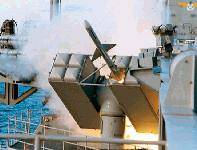 |
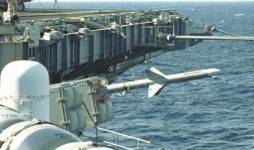 |
Description:
The RIM-7 Sparrow is a highly maneuverable air-to-air missile with surface-to-air capability. The missile has a cylindrical body with four wings at mid-body and four tail fins.
The missile is used by the U.S. Navy, the U.S. Army, the U.S.M.C., and NATO members. It can be launched by ships and planes. The U.S. Navy has two launchers to fire the missile: the MK 29 Mod 1 Sea Sparrow launcher (used by foreign navies, too) and the MK 41 VLS.
Aboard AEGIS ships the Navy uses the MK 41 VLS to launch the Sea Sparrow missiles. Because of the vertical launch of the missile a Jet Vane Control unit (JVC) is necessary to cancle the missile's initial upward velocity and control transition to the initial intercept path. After the seeker is pointing toward a target, the JVC is jettisoned. A quick-reaction, 360-degree defense and eliminating trainable firing restriction and time consuming slew requirement is provided by vertical launch.
To steer the missile uses its wings while the Evolved Sea Sparrow Missile (ESSM) uses skid-to-turn steering (tail control).
General Characteristics:
| Primary Function |
Air-to-Air and surface-to-air radar-guided missile |
| Contractors |
originally developed by Sperry later versions developed by:
Raytheon Co. and
General Dynamics |
| Power Plant |
Hercules MK-58 solid-propellant rocket motor |
| Length |
12 feet; 3.66 meters |
| Diameter |
8 inches; 20.32 cm |
| Wingspan |
3 feet, 4 inches; 101.6 cm |
| Speed |
2,660+ mph; 4,280+ km/h |
| Range |
30+ nautical miles; 34.5+ statue miles; 55.5+ km
Max Range = 6 nm according to other sources
Minimum Range: 1,600 yards; 1463 meters
Director Lock-on range: 50nm |
| Warhead |
Annular blast fragmentation warhead, 90 pounds (40.5 kg)
Proximity fuzed, continuous expanding rod, with a 27 ft. kill radius |
| Fire Control System |
MK 91 |
| Launcher |
MK 29 Mod 1 |
| Aircraft Platforms |
F-4 Phantom
F-14 Tomcat
F-15 Eagle
F-16 Figthing Falcon
F-18 (Super-)Hornet
and future aircraft |
| Launch Weight |
approx 500pounds; 225kg |
| Guidance System |
Raytheon semi-active on continuous wave or pulsed Doppler radar energy |
| Unit Cost |
$165,400 |
| Date Deployed |
1976 |
The Launchers:
The NATO MK 29 Mod 1 launcher (left and right image below) can be found aboard many US NAVY ships such as Aircraft Carriers and Amphibious Assault Ships and many foreign NATO ships. The MK 41 VLS (center image below) can be found aboard TICONDEROGA-class cruisers, the ARLEIGH BURKE-class and the SPRUANCE-class destroyers. Only AEGIS ships (the TICONDEROGA-class and the ARLEIGH BURKE-class) use the VLS to launch Sea Sparrow missiles.
The MK-25 and Mk-29 Launchers:
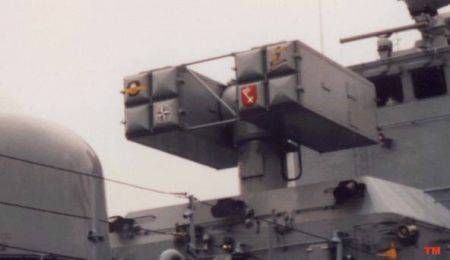 In the 1960th the Navy created a new anti-air system. This system was named BPDMS (Basic Point Defense Missile System). It consisted of the Mk 25 launcher and of adapted Sea Sparrow missiles. The design of this launcher was similar to the ASROC missile launcher. In the 1960th the Navy created a new anti-air system. This system was named BPDMS (Basic Point Defense Missile System). It consisted of the Mk 25 launcher and of adapted Sea Sparrow missiles. The design of this launcher was similar to the ASROC missile launcher.
Shortly after introduction of the BPDMS many ships without Standard-Systems got the new system because the whole installation was not very expensive. A disadvantage was the short range of just 18 kilometers.
In 1974 a new launcher was introduced: The Mk 29 Sea Sparrow launcher. It had a lower weight and did not use the RIM-7G but the improved RIM-7H missiles. Today, this launcher is also used by many NATO navies. This system is also known as IPDMS (Improved Point Defense Missile System).
Today, there is no US Navy ship left equipped with the MK-25 launcher.
|
Mk 25 Mod. 1 |
Mk 29 Mod. 0 (older version) |
| Missiles launched |
RIM-7G |
RIM-7H |
| Number of missiles |
8 |
8 |
| Weight (in tons) |
14,5 |
10,9 - 12,7 |
| Used aboard... |
CV, CVN, FF, LHA, LPH |
CV, CVN, FF, DD, LHA, LHD and some Auxiliary Vessels |
| Guidance System |
Mk 115 |
Mk 91 |
| Introduced |
1967 |
1974 |
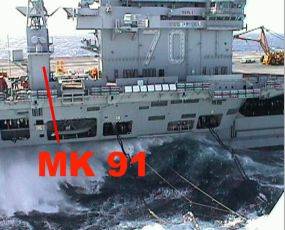 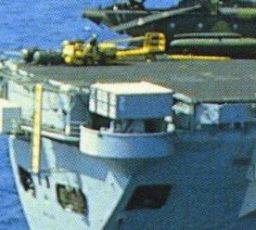
Click here to view BPDS Missile Gallery
|